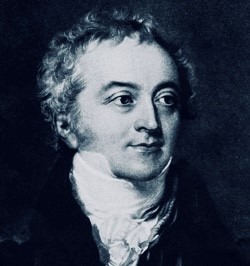Who was Thomas Young?
The Thomas Young Centre is named after the extraordinary polymath Thomas Young FRS (1773-1829), who made breakthroughs in more fields than our amalgamated research can possibly cover. His understanding of the human eye and vision – arising from his initial training as a physician – earned him a Fellowship of the Royal Society at the age of just twenty-one. Yet much of Young’s bounty of discoveries was appreciated by scientists only after his death in 1829.

Today, Thomas Young is well known as a physicist (compared with Isaac Newton by Albert Einstein): the first to establish – with “Young’s Slits” – the wave nature of light, perhaps his most wonderful legacy, with its modern implications for the nature of quantum mechanics. Young was the materials scientist and engineer who gave us “Young’s Modulus”. His proposal of the three-colour theory of vision eventually became known as the “Young-Helmholtz” theory. In addition, he was a skilled linguist with a deep knowledge of ancient languages, who coined the term “Indo-European”, and was seminal in decoding Egyptian hieroglyphs: a task completed by Champollion in the 1820s. It is no wonder that the Blue Plaque on Young’s house at 48 Welbeck Street in central London calls him “Man of Science”.
In his autobiography, Young wrote: “It is probably best for mankind that the researches of some investigators should be conceived within a narrow compass, while others pass more rapidly through a more extensive sphere of research.”
If you’d like to find out more, a recently revised edition of Andrew Robinson’s 2006 biography of Thomas Young, The Last Man Who Knew Everything will be published in May 2023: https://www.openbookpublishers.com/books/10.11647/obp.0344
